Jorge Ramírez-González[1], José Marín Jarrín[1,2], Solange Andrade-Vera[1], Michael Tanner[1], Pelayo Salinas-de-León[1,3], María José Barragán[1]
[1]Charles Darwin Research Station, Charles Darwin Foundation, [2]Humbolt State University, [3]National Geographic Society
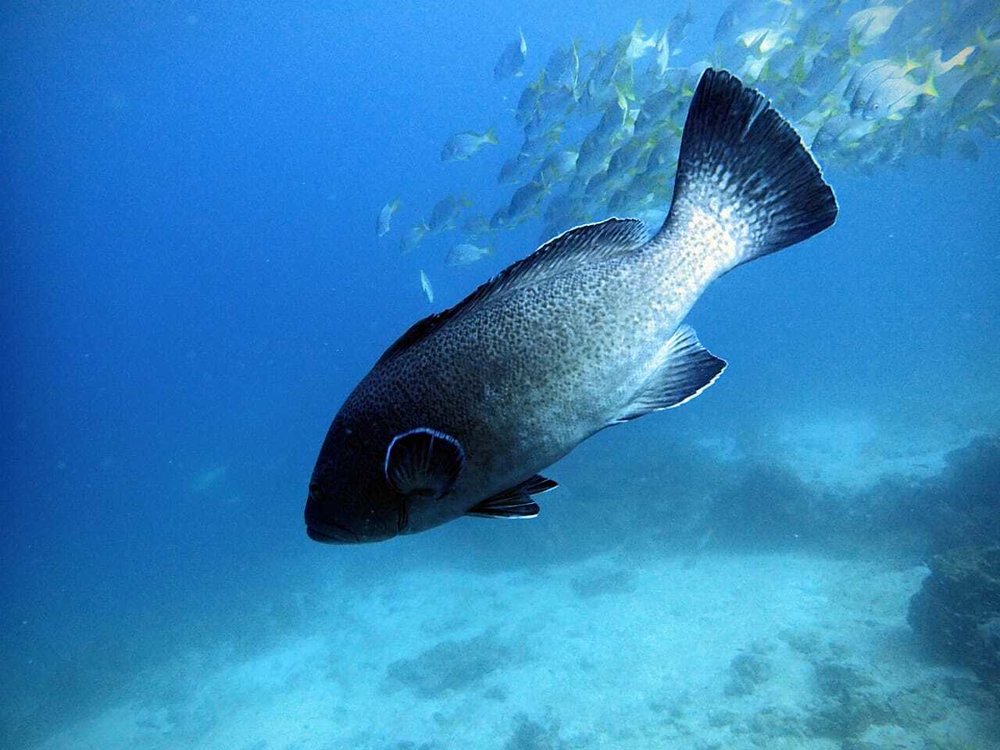
Figure 1. Galapagos grouper. Photo: Salomé Buglass, Charles Darwin Foundation
Artisanal fishing is permitted for more than 50 fish species in the Galapagos Marine Reserve (Castrejón 2009). However, fish catch size requirements, seasonal closures, and other specific management measures do not exist for any of these species (Galapagos National Park Directorate et al. 2016), raising conservation concerns. Overfishing can cause serious ecological impacts, such as ecosystem destabilization due to changes in the food chain. It can also cause economic impacts such as reduced income for fishermen, and social impacts such as conflicts between fishermen, authorities, and other Marine Reserve users (FAO 2018).

Since 2009, the Charles Darwin Foundation and several university collaborators have conducted studies to better understand the conservation status of the most important fish species for coastal and deep water fisheries in Galapagos: Galapagos grouper (Mycteroperca olfax), sand bass (Paralabrax albomaculatus), and mottled scorpionfish (Pontinus clemensi) (Figure 2). This article describes the main findings of these studies, the conservation challenges facing these three species, and possible responses.
THE LIFE HISTORY OF GALAPAGOS GROUPER, SAND BASS AND MOTTLED SCORPIONFISH
To better understand the life history of each of these species in Galapagos, we first focused on the age structure of their populations. From 2009 to 2018 we collected individuals from each species, measured their size, and extracted ear bones called otoliths (Figure 3). These small bones form lines as a fish grows, which can then be counted, like the rings in a tree trunk, to determine the age of a fish. After analyzing otoliths from fish of different sizes, we can develop formulas to estimate the age of a fish based on its size alone.
We also analyzed the reproductive systems of the fish we collected, in order to determine at what age and size, and during which months of year each species reproduces.
We analyzed a total of 297 Galapagos grouper, 547 sand bass and 420 mottled scorpionfish. We now know that these species live much longer than other fishes, and that it takes them many years to reach reproductive age. Species that take a long time to grow and reproduce are the most vulnerable to overfishing.
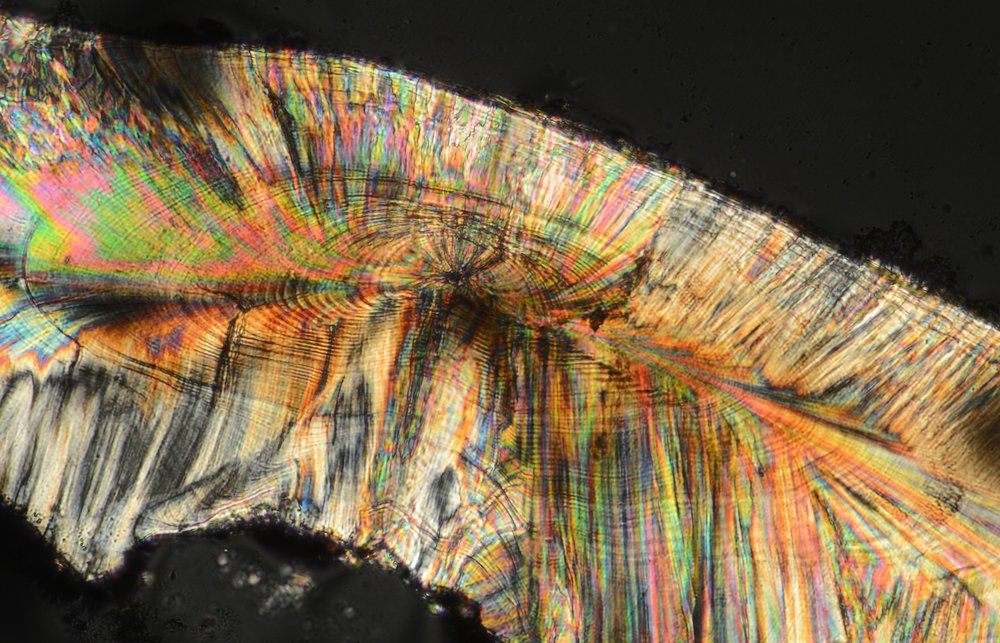
Figure 3. Image of a Galapagos grouper’s otolith under a microscope, showing the circular growth lines. Photo: Solange Andrade, Charles Darwin Foundation
We also learned that older female sand bass are mega-reproducers that spawn up to 23 times more offspring than younger females. For example, a four-year-old female sand bass produces up to 23,300 eggs, while an eight-year-old produces up to 542,000 eggs (Salinas-de-León et al.2017). This type of data is very important for establishing maximum size limits to protect such “mega mamas.”
In 2012 and 2014 we also conducted dives to census Galapagos grouper populations and to identify their breeding sites. Our underwater censuses revealed the presence of a grouper spawning aggregation at Wolf Island in the northern part of the Galapagos Archipelago. There we observed grouper densities 12 times higher than in other sites where there was no reproductive activity. We also documented sexually mature groupers, with extended abdomens and changes in coloration, defending their territory. We suspect that similar sites used to exist throughout the Galapagos Marine Reserve, but that some may have disappeared due to overfishing (Salinas-de-León et al. 2015a).
![Table 1. Life history of Galapagos grouper, sea bass and mottled scorpionfish in the Galapagos Marine Reserve. TL = total length. Sources: [1]Usseglio et al. (2015); [2]Salinas-de-León et al. (2017), [2]Salinas-de-Leónet al. (20 15b); [3]Marin Jarrín et al. (2018).](https://reports.galapagos.org/wp-content/uploads/2022/10/ScreenShot2019-07-11at2.59.06PM-1-1.png)
Table 1. Life history of Galapagos grouper, sea bass and mottled scorpionfish in the Galapagos Marine Reserve. TL = total length. Sources: [1]Usseglio et al. (2015); [2]Salinas-de-León et al. (2017), [2]Salinas-de-Leónet al. (20 15b); [3]Marin Jarrín et al. (2018).
HEALTH STATUS OF GALAPAGOS GROUPER, SAND BASS AND MOTTLED SCORPIONFISH
Three indicators reflect the health status of grouper, sand bass and mottled scorpionfish: the percentage of mature fish in a catch, the percentage of specimens with optimum length (i.e., the size resulting in greatest economic benefit to fishermen), and the percentage of mega‐reproducers (Froese 2004). With the help of observers aboard fishing boats and fishermen at the Pelikan Bay pier in Puerto Ayora, we collected catch data on all three species.
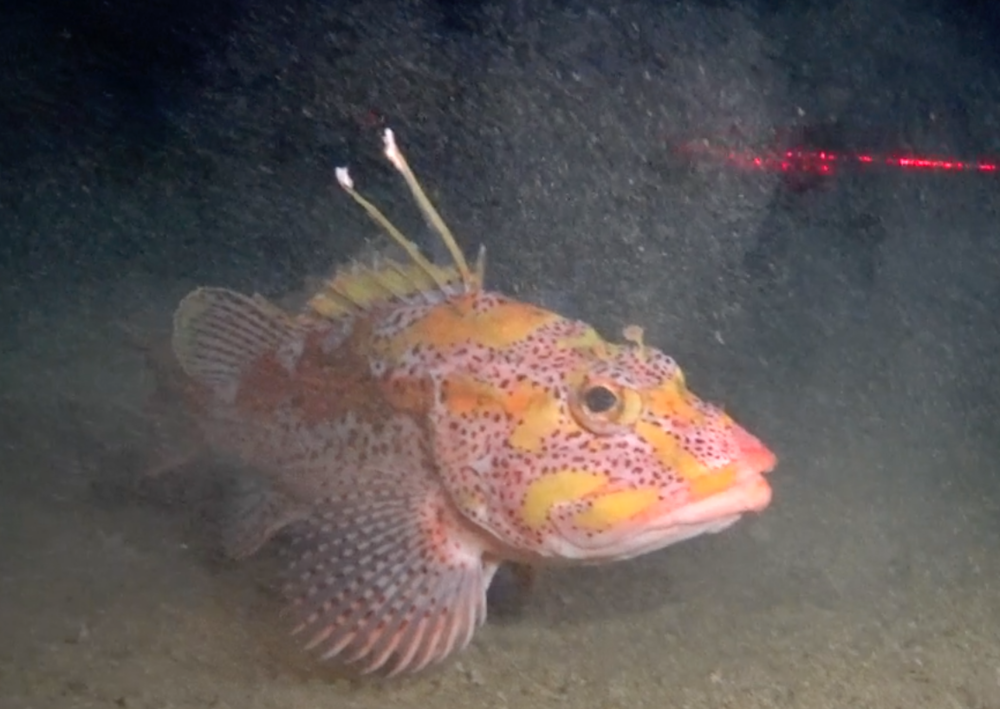
Figure 4. Mottled scorpionfish. Photo: Salomé Buglass, Charles Darwin Foundation
Our findings justify our concern for these species in the Galapagos Marine Reserve (Table 2). Grouper are not being allowed to fully mature; an average of eight of every 10 fish we sampled had not reached reproductive age. Fishermen are also no longer catching optimal-sized fish. Morever, we observed that mega-reproducers – those individuals of great biological value that are essential for maintaining healthy populations – were relatively infrequent.
![Table 2. The status of grouper, sea bass and mottled scorpionfish in the Galapagos Marine Reserve, according to Froese (2004)’s three indicators. Sources: [1]Usseglio et al. (2016); [2]Salinas-de-Leónet al. (2015b); [3]Unpublished data of the Charles Darwin Foundation](https://reports.galapagos.org/wp-content/uploads/2022/10/ScreenShot2019-07-21at1.39.20PM-2.png)
Table 2. The status of grouper, sea bass and mottled scorpionfish in the Galapagos Marine Reserve, according to Froese (2004)’s three indicators. Sources: [1]Usseglio et al. (2016); [2]Salinas-de-Leónet al. (2015b); [3]Unpublished data of the Charles Darwin Foundation
This situation is particularly troubling because these three species are unique and important to Galapagos. Galapagos grouper live exclusively in the Eastern Tropical Pacific (Ecuador, Colombia and Costa Rica), with 99% of the population found in the Galapagos Marine Reserve. The International Union for the Conservation of Nature lists Galapagos grouper as a vulnerable species (Bertoncini et al. 2008). Sand bass is endemic to Galapagos, found nowhere else in the world, and is listed as endangered (Robertson et al. 2010). This is the same threat level as charismatic species like the Galapagos penguin and fur seal. The mottled scorpionfish also lives only in the Eastern Tropical Pacific (Mora et al.2000) and is the main prey of the Galapagos sea lion (Zalophus Wollebaeki) (Páez-Rosas and Aurioles-Gamboa 2014).
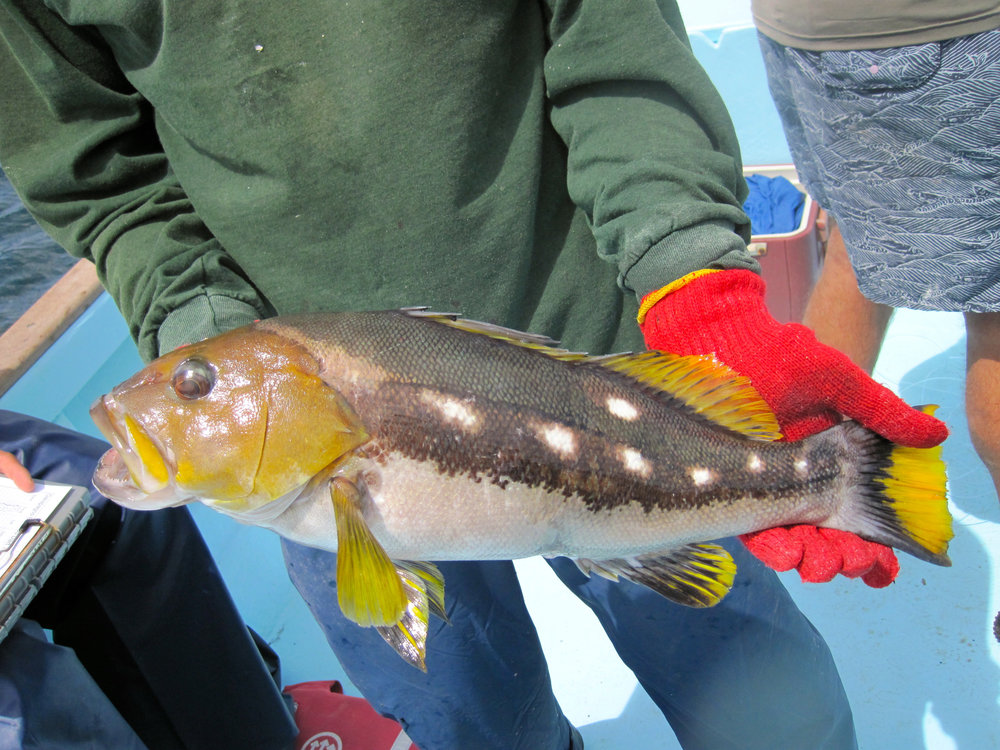
Figure 5. Sand bass. Photo: Charles Darwin Foundation
Based on our data, we concluded that grouper and sand bass are overexploited in Galapagos and that mottled scorpionfish is possibly overexploited (Table 2). We sought to come up with ways to change this situation, to allow these species to recover and to ensure sustained income for fishermen.
YELLOWFIN TUNA TO THE RESCUE
In 2016 the Galapagos National Park Directorate, with support from WildAid, installed four Fish Aggregating Devices (FADs) in the Galapagos Marine Reserve, one for each fishing cooperative (Figure 6). FADs are fixed buoys measuring more than a meter in diameter with netting that attracts pelagic species such as yellowfin tuna (Thunnus albacares) (Fig. 7).
It occurred to us that FADs could serve to decrease fishing pressure on Galapagos grouper, sand bass and mottled scorpionfish. FADs could reduce the costs associated with locating and traveling to fishing sites, because FADs are placed in well-known and easily accessible locations. In addition, yellowfin tuna reproduce at an early age (2-3 years) (Sun et al. 2005), which makes this species more resistant to overfishing.
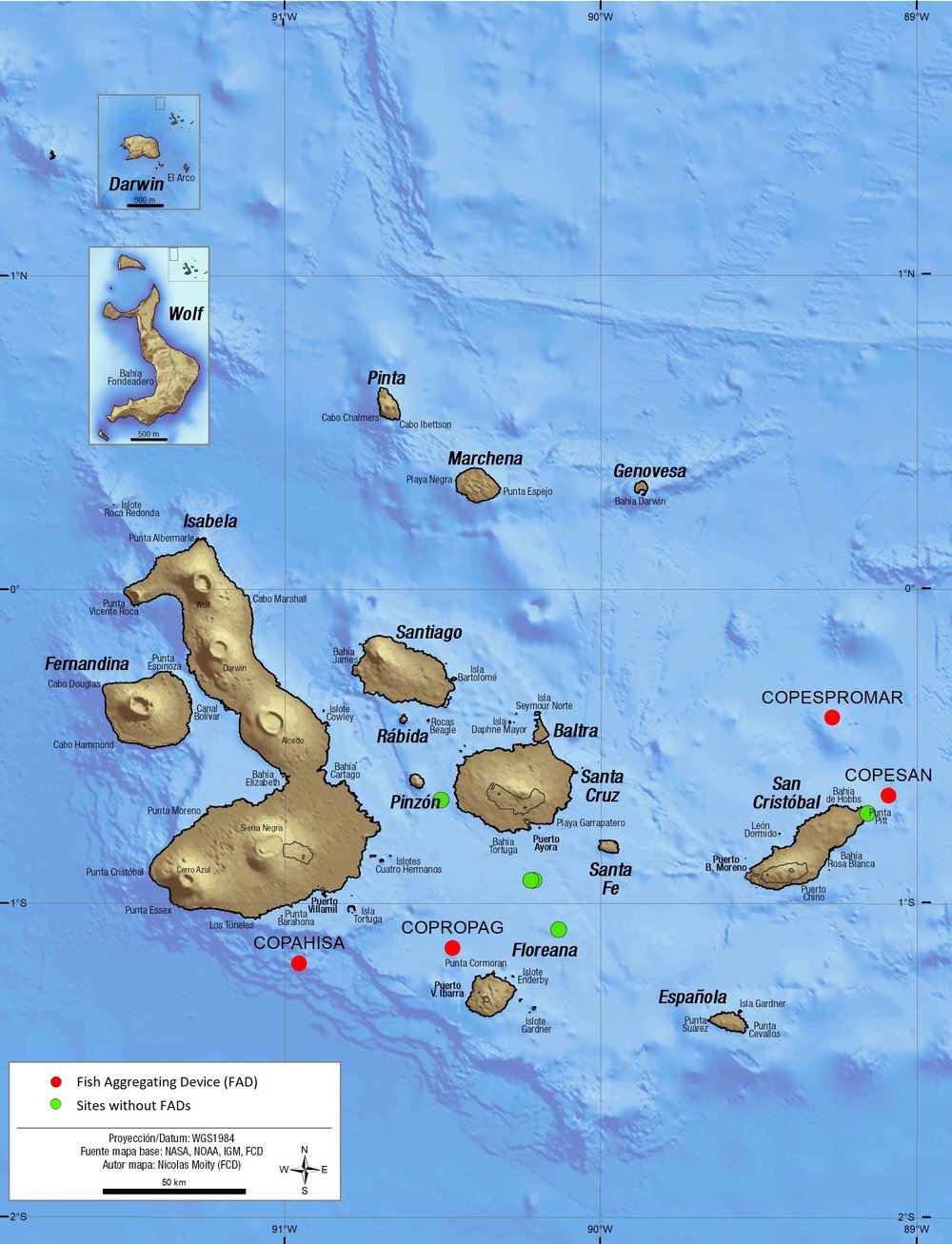
Figure 6. Locations of FADs and sampling sites without FADs in the Galapagos Marine Reserve. COPAHISA = Horizons of Isabela Artisanal Fishing Cooperative; COPROPAG = Galapagos Artisanal Fishing Cooperative; COPESAN = San Cristobal Artisanal Fishing Cooperative; COPESPROMAR = Sea Product Fishing Cooperative. Produced by: Nicolas Moity, Charles Darwin Foundation.
To determine the potential of FADs as a sustainable fishing tool, we studied their effectiveness from an environmental and economic standpoint. Working together with the Galapagos National Park Directorate and artisanal fishermen from Galapagos fishing cooperatives, we participated in fishing trips to compare the catch per unit of effort (CPUE) and the size of yellowfin tuna caught at sites with and without FADs (Figure 6), both during and between fishing seasons. We measured CPUE in kilograms of yellowfin captured per hook per hour.
In each FAD we also placed satellite buoys that recorded the total biomass of fish in their vicinity (Figures 7 and 8).
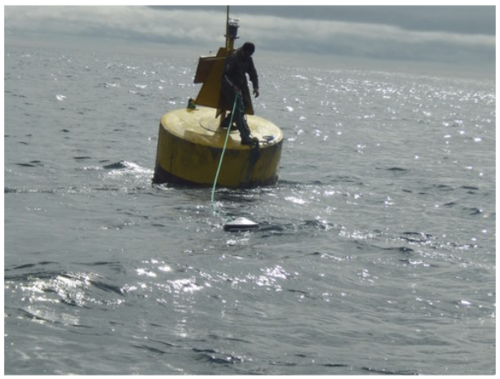
Figure 7. FAD with satellite buoy installed. The satellite buoy records the biomass of fish in the vicinity of the FAD. Photo: José Marín Jarrín, Fundación Charles Darwin
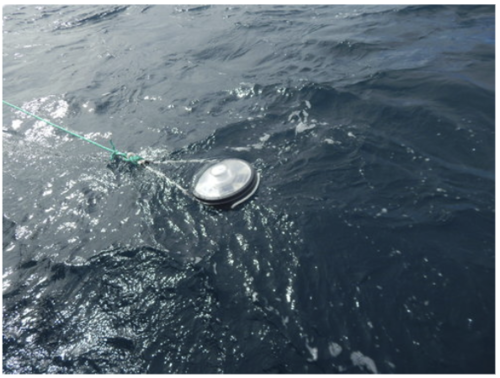
Figure 8. Satellite buoy. Photo: José Marín Jarrín, Fundación Charles Darwin
Finally, we calculated the net profit of each fishing trip, considering the price per pound of fish sold and the fixed and variable costs associated with the trip.
In total we participated in 39 fishing trips and found that FADs did attract pelagic species, especially yellowfin tuna, but that some trips resulted in economic losses (Table 3). The question is: Why?
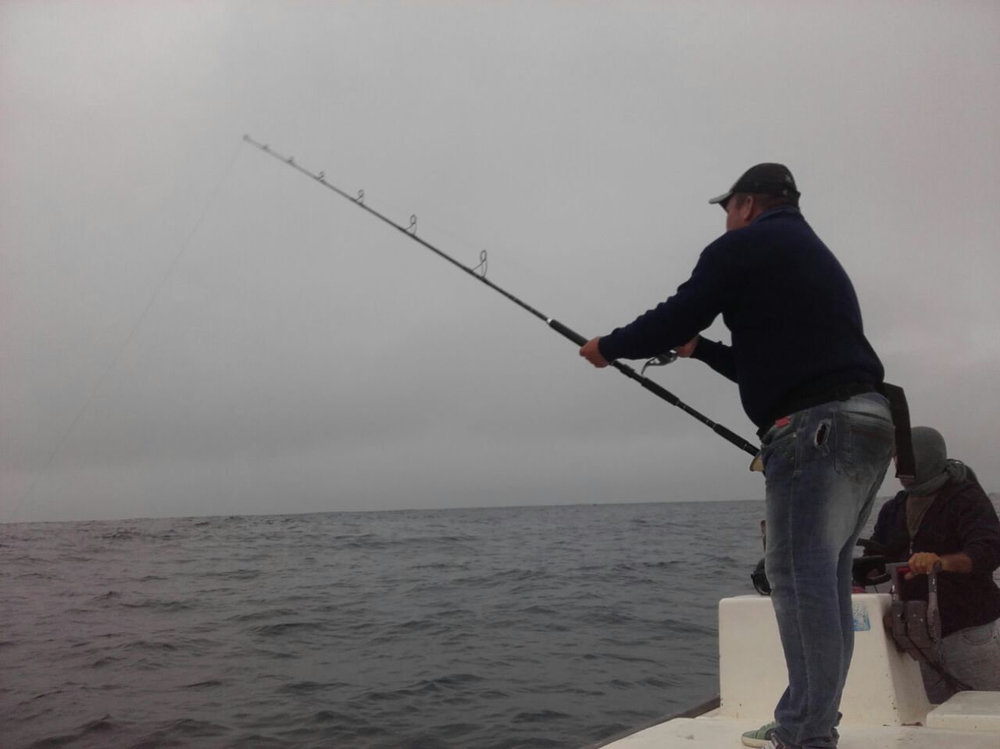
Figure 8. Rod fishing for yellowfin tuna at an FAD. Photo: Jose Marin, Charles Darwin Foundation
One reason is that the yellowfin tuna were located at depths at which Galapagos fishermen do not traditionally fish (55 to 115 meters). Another reason is that the Galapagos market for yellowfin tuna is still limited. On Isabela Island, only the small local population consumes yellowfin, while yellowfin tunas caught on the other islands aren’t exported because most are small and command a low price. For example, during the period of our study, the Galapagos Artisanal Fishing Cooperative would not accept yellowfin weighing less than 50 pounds. For these reasons, fishermen generally prefer to fish for coastal and pelagic species in sites without FADs.

Table 3. Minimum, maximum and average values of pelagic fish variables at FADs in the Galapagos Marine Reserve: kg –kilograms, CM-centimeters, TM –metric tons. Sources: Moina et al. (2018) and unpublished data from the Charles Darwin Foundation.
ADDING VALUE TO YELLOWFIN TUNA
Armed with the realization that the market is a very important factor affecting fishermen’s interest in FADs, we began to study how much potential consumers would be willing to pay for Galapagos yellowfin tuna if it were certified or had an eco-label.
Our research used the concept of the “Galapagos Seal for Artisanal Fishery Products” which was designed by the Galapagos National Park Directorate, WWF Ecuador and the Galapagos Artisanal Fishing Cooperative. This certificate guarantees consumers that the fish they buy is from Galapagos and was caught by legally registered fishermen using environmentally friendly fishing practices that can be traced. We interviewed national and foreign tourists at different locations in Puerto Ayora, Santa Cruz.
We received responses from 393 tourists and determined that they would be willing to pay US$4.25 per pound of certified yellowfin tuna, compared to current prices that range from US$2.50 to US$3.00 per pound. This represents an increase of more than $100,000 per year in potential revenue for Galapagos. In other words, certification is what the yellowfin tuna fishery needs to save Galapagos grouper, sea bass and mottled scorpionfish from overexploitation.
RECOMMENDATIONS
We propose the following management measures to reverse the overfishing of Galapagos grouper, sea bass and mottled scorpionfish:
Implement the fish size requirements and seasonal closures suggested in Table 4. The proposed closures coincide with periods of greatest reproduction of each species.

Table 4. Management recommendations for grouper, sea bass and mottled scorpionfish in the Galapagos Marine Reserve.
Measure the size of fishes captured during monitoring activities that the Galapagos National Park Directorate undertakes in Galapagos ports, in order to determine the health status of grouper, sea bass and mottled scorpionfish populations on an annual basis.
Locate the breeding sites of each of the three species and implement measures to protect them.
Ensure the Galapagos protected area zoning system protects the grouper spawning aggregation at Wolf Island.
Certify the yellowfin tuna fishery to increase the income of fishermen.
Continue to study FADs to identify the factors that affect their effectiveness in Galapagos, such as sea temperature and ocean currents. This will allow us to determine when and how FADs could provide attractive fishing sites for local fishermen.
ACKNOWLEDGEMENTS
This research was led by José R. Marín Jarrin, Solange Andrade Vera, Michael Tanner, Nicolás Moity and Pelayo Salinas de León (Staff of the Charles Darwin Foundation). We would like to thank Paolo Suseglio, Alan Friedlander, Richard Preziosi, Alicia Bertolotti, Emy Moina, Joe Castillo, Jean Carlos Dancen, Andrés Castillo, Jodie Savage, Lisseth Vega, Teresa Villavicencio, Carla Brito, Emily Witt, Sarah Valley, Raji Scoggin, César Reyes, José Feijo, Carolina Chong, I. Haro-Bilbao and Jorge Baque, staff and volunteers of the Charles Darwin Foundation. The field work was carried out with the support of Nelson Ibarra, Carlos Dancen, Marcos Dancen, Leopoldo Ayala, Faustino Villarroel, Carlos Cabezas, Oscar Intriago and the crew of M.V. Oberlús, members of the Galapagos fishing cooperatives. Our work has been carried out in collaboration with the Galapagos National Park Directorate, especially with Harry Reyes and Ricardo Visaira, through research permit No. PC-13-18 “Ecology, Assessment and Management of Fisheries: Steps Towards Sustainability,” and the National Fisheries Institute; and was made possible by the financial support of the Leona M. and Harry B. Hemsley Foundation, Lindblad Expeditions, National Fund for Conservation and Research, the Galapagos Conservation Trust, the Mohammed Fund for Species Conservation, the Disney Global Conservation Fund, Mohammed Bin Zaye, the Ataman Foundation Ataman and the Gordon and Betty Moore Foundation.
REFERENCES
Bertoncini AA, Gerhardinger LC, Sadovy YJ, Rocha L, Choat JH, Ferreira y M Craig. 2008. Mycteroperca olfax. The IUCN Red List of Threatened Species 2015. http://dx.doi.org/10.2305/IUCN.UK.2015-3.RLTS.T14051A79474097. Visto el 16 de octubre de 2018.
Castrejón MMH. 2009. Co-manejo pesquero en la Reserva Marina de Galápagos: tendencias, retos y perspectivas de cambio. Fundación Tinker, Fundación Charles Darwin, Kanankil/Plaza y Valdés. Galápagos-Ecuador. 416 pp.
Dirección del Parque Nacional Galápagos, Comisión Técnica Pesquera y Sector Pesquero Artesanal de Galápagos. 2016. Calendario Pesquero 2016-2021. Estudio técnico. DPNG. Galápagos-Ecuador. 20 pp.
FAO. 2018. El estado mundial de la pesca y la acuicultura 2018. Cumplir los objetivos de desarrollo sostenible. Roma. Licencia: CC BY-NC-SA 3.0 IGO.
Froese R. 2004. Keep it simple: three indicators to deal with overfishing. Fish and Fisheries. 5(1):86–91.
Marín Jarrín JR, Andrade-Vera S, Reyes-Ojedis C & P Salinas-de-León. 2018. Life History of the Mottled Scorpionfish, Pontinus clemensi, in the Galapagos Marine Reserve. Copeia. No.3:515-523
Moina QE, Visaira CR, Andrade-Vera S, Reyes H & JR Marín-Jarrín. 2018. Evaluación del uso de Dispositivos Agregadores de Peces para asegurar la sostenibilidad de las pesquerías en las Galápagos. Informe técnico. DPNG-FCD. Galápagos-Ecuador. 15 pp.
Mora C, Jiménez JM & FA Zapata. 2000. Pontinus clemensi (Pisces: Scorpaenidae) at Malpelo Island, Colombia: new specimen and geographic range extension. Boletín de Investigaciones Marinas Costeras. 29: 85–88.
Páez-Rosas D & D Aurioles-Gamboa. 2014. Spatial variation in the foraging behaviour of the Galapagos sea lions (Zalophus wollebaeki) assessed using scat collections and stable isotope analysis. Journal of the Marine Biological Association of the United Kingdom. 94:1099–1107
Robertson R, Allen G, Dominici-Arosemena A, Edgar G, Rivera F & G Merlen. 2010. Paralabrax albomaculatus. The IUCN Red List of Threatened Species 2010. http://dx.doi.org/10.2305/IUCN.UK.2010-3.RLTS.T183769A8173211.en Vista el 16 de octubre 2018. Visto el 16 de octubre de 2018.
Salinas-de-León P, Rastoin E, & D Acuña-Marrero. 2015a. First record of a spawning aggregation for the tropical eastern Pacific endemic grouper Mycteroperca olfax in the Galapagos Marine Reserve. Journal of Fish Biology. 87(1). DOI: 10.1111/jfb.12703
Salinas-de-León P, Bertolotti A, Chong-Montenegro C, Marriott A, Reyes H & RF Preziosi. 2015b. Historia de vida y dinámica pesquera del camotillo (Paralabrax albomaculatus). Informe resumen para la Comisión Técnica Pesquera de la Junta de Manejo Participativo de la RMG. FCD. 9 pp.
Salinas-de-León P, Bertolotti A, Chong-Montenegro C, Gomes-Do-Régo M & RF Preziosi. 2017. Reproductive biology of the endangered white-spotted sand bass Paralabrax albomaculatus endemic to the Galapagos Islands. Endangered Species Research. Vol 34:301-309.
Sun, Chi-Lu, Wei-Jen W & Y Su-Zan. 2005. Reproductive biology of the female yellowfin tuna Thunnus albacares in the western Pacific Ocean. 1st Meeting of the Scientific Committee of the Western and Central Pacific Fisheries Commission, WCPFC-SCI. 8-19 agosto. Noumea, Nueva Caledonia.
Usseglio P, Fiedlander AM, DeMartini EE, Schuhbauer A, Schemmel E & P Salinas-de-León. 2015. Improved estimates of age, growth and reproduction for the regionally endemic Galapagos sailfin grouper Mycteroperca olfax (Jenyns, 1840). PeerJ. 3:e1270. DOI:10.7717/peerj.1270
Usseglio P, Friedlander AM, Koike H, Zimmerhackel J, Schuhbauer A, Eddy T & P Salinas-de-León. 2016. So Long and Thanks for All the Fish: Overexploitation of the Regionally Endemic Galapagos Grouper Mycteroperca olfax (Jenyns, 1840). PLoS ONE 11(10):e0165167. DOI:10.1371/ journal.pone.0165167
